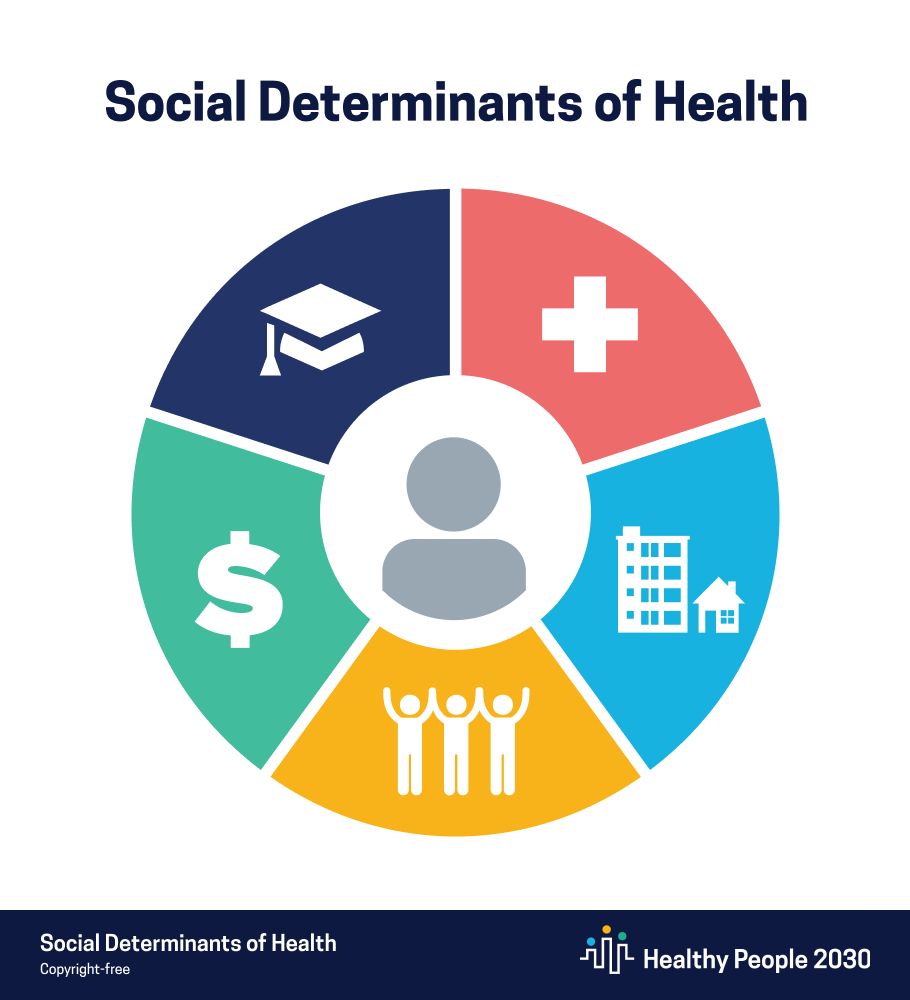The 5 Core SDOH Domains
With an increased focus on social determinants of health (SDOH) around the world, it should come as no surprise that the topic is making its way into U.S. government-led initiatives. The Healthy People 2030 initiative outlines 5 core areas as areas of focus that should be considered for SDOH work.

When it comes to healthcare technology most would agree that a significant driver for innovation and new functionality is U.S. healthcare policy and government-related initiatives. This is also true for health IT efforts around Social Determinants of Health (SDOH).
The main factors that drive U.S influence in health IT are two-fold. First, many well-established vendors along with health IT startups have head offices in U.S. locations. The second factor is that the U.S. market share is one of the largest in the world and the way it is structured involves both private and public payers. Making it the perfect 'testing ground' for all types of business models and a very lucrative market.
With an increased focus on SDOH around the world, it should come as no surprise that the topic is making its way into U.S. government-led initiatives. Including those by the U.S. Department of Health and Human Services (HHS), which includes the Centers for Disease Control (CDC), the Center for Medicare and Medicaid Services (CMS), and the Office of the National Coordinator for Health Information Technology (ONC) among its many divisions.
The Healthy People Initiative
At the beginning of each decade, HHS establishes a set of 10-year objectives that it will focus on to improve the well-being and overall health for individuals with the country. These are published as the Healthy People Initiative. Along with the objective list, HHS also provides states, communities, and individuals with a number of tools and data items that will help them to achieve their health goals and defined targets. (End of decade snapshot for Healthy People 2020.)
Healthy People 2030 contains 355 measurable objectives that have been organized into 5 main topic areas.
- Health Conditions
- Health Behaviors
- Populations
- Setting and Systems
- Social Determinants of Health
Each of the individual objectives are assigned a type by workgroups containing a number of topic subject matter experts. The three types are:
Core Objectives - Within this group are a number of high-priority items where a statistical source for data has been identified. The data must be from no earlier than 2015 and needs to represent the entire nation. With core objectives there is confidence that at least two additional data points that can be measured will present themselves within the next 10-years. Core objectives are items where analysis on the baseline data continues, along with work on forming target improvement levels and the determination of appropriate implementation timelines.
Developmental Objectives - For each of these high-priority issues there are some evidence-based interventions that have been identified to address deficiencies and gaps. However, the level of baseline data that is currently available is not sufficient to properly measure changes observed in the observation metrics over the course of the 10-year period.
Research Objectives - For the items that fall into this grouping, more research is required to identify and assess evidence-based interventions that can be used to improve the health and wellbeing of individuals.

As you can see SDOH represents one of the 5 topic areas for the Healthy People 2030 initiative. To help outline the objective focus areas, HHS has further organized the topic of SDOH into 5 core domain areas. (Note that these domains are now being used across all HHS divisions including, CMS, ONC and the CDC.)
Economic Stability
Goal: "Help people earn steady income that allow them to meet their health needs."
The Economic Stability domain contains 9 core objectives (for baseline measurement only). It is well established that individuals who have steady employment are more likely to be able to afford housing, healthy foods, and the healthcare services that they may need. This domain focuses on improving objectives that impact an individuals ability to obtain or maintain a steady income. It includes things related to employment programs, reliable child-care, and early interventions on factors that may limit someone's ability to work.
Education Access and Quality
Goal: "Increase educational opportunities and help children and adolescents do well in school."
The Education Access and Quality domain contains 5 core objectives (for baseline measurement only), along with 4 developmental and 3 research items. Objectives within this domain area are focused on improving levels of education throughout the population. It has been well documented over the years that individuals with higher education levels tend to live longer and experience improved health and wellness when compared to those that are less educated. Target areas for objective improvement include children with disabilities, children and adolescents living in low-income environments, and youth who routinely experience things like bullying and discrimination.
Healthcare Access and Quality
Goal: "Increase access to comprehensive, high-quality health care services."
The Healthcare Access and Quality domain contains 34 core objectives (for baseline measurement only), along with 9 developmental and 7 research items. Objectives within this domain area are focused on improving individuals health by working towards increasing the number of individuals with access to a primary care provider; decreasing the number of individuals without appropriate health insurance coverage; and improving access to services and medications where affordability may be a factor. While the objectives in this domain span a variety of subdomain areas, there are a few of note mentioned in the Health IT area.
- HC/HIT-06 - Increase the proportion of adults offered online access to their medical record. (Core: baseline)
- HC/HIT-D05 - Increase the proportion of hospitals that exchange and use outside electronic health information. (Developmental)
- HC/HIT-D06 - Increase the proportion of hospitals with access to necessary electronic information. (Developmental)
- HC/HIT-D07 - Increase the proportion of doctors with electronic access to information they need. (Developmental)
- HC/HIT-D08 - Increase the proportion of doctors who exchange and use outside electronic health information. (Developmental)
- HC/HIT/-D09 - Increase the proportion of people who can view, download, and send their electronic health information. (Developmental)
- HC/HIT-D10 - Increase the proportion of people who say their online medical record is easy to understand. (Developmental)
- AHS-R02 - Increase the use of Telehealth to improve access to health services (Research)
Neighborhood and Built Environment
Goal: "Create neighborhoods and environments that promote health and safety.
The Education Access and Quality domain contains 22 core objectives (for baseline measurement only), along with 6 developmental items and 1 research objective. The domain is focused on measuring and working to improving safety for individuals in all areas where they may live, socialize, congregate, and work. Health risks are unfortunately plentiful in areas where there are high levels of crime, poor sanitation, unsafe air quality, and increased incidents of domestic violence. Within the U.S., and many other countries, there is a disproportionate number of racial and ethnic minorities that are often located within these neighborhoods. Impacts to health and well-being for these individuals is often compounded by challenges they face within the other SDOH domains. From a Health IT perspective, this domain has one identified objective.
- HC/HIT-05 - Increase the proportion of adults with broadband internet. (Core: baseline)
Social and Community Context
Goal: "Increase social and community support."
The Social and Community Context domain contains 8 core objectives (for baseline measurement only), along with 3 developmental and 2 research items. An individual's health can often be impacted by the nature of their relationships with others. Those that have strong ties to family, friends, and community are more likely to take better care of themselves. A strong social network can also assist with mitigating some of the negative impacts associated with other SDOH domains. For example, individuals may find support from their social connections when they experience discrimination, incidents of violence, or challenges with basis necessities. Within this domain, there are three objectives that relate directly to Health IT.
- HC/HIT-04 - Increase the proportion of adults who talk to friends or family about their health. (Core: baseline)
- HC/HIT-R01 - Increase the health literacy of the population. (Research)
- HC/HIT-07 - Increase the proportion of adults who use IT to track health care data or communicate with providers. (Core: baseline)

